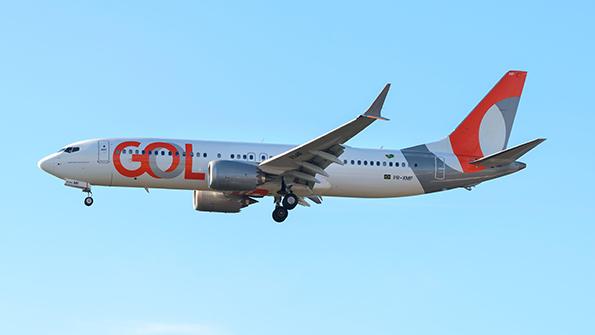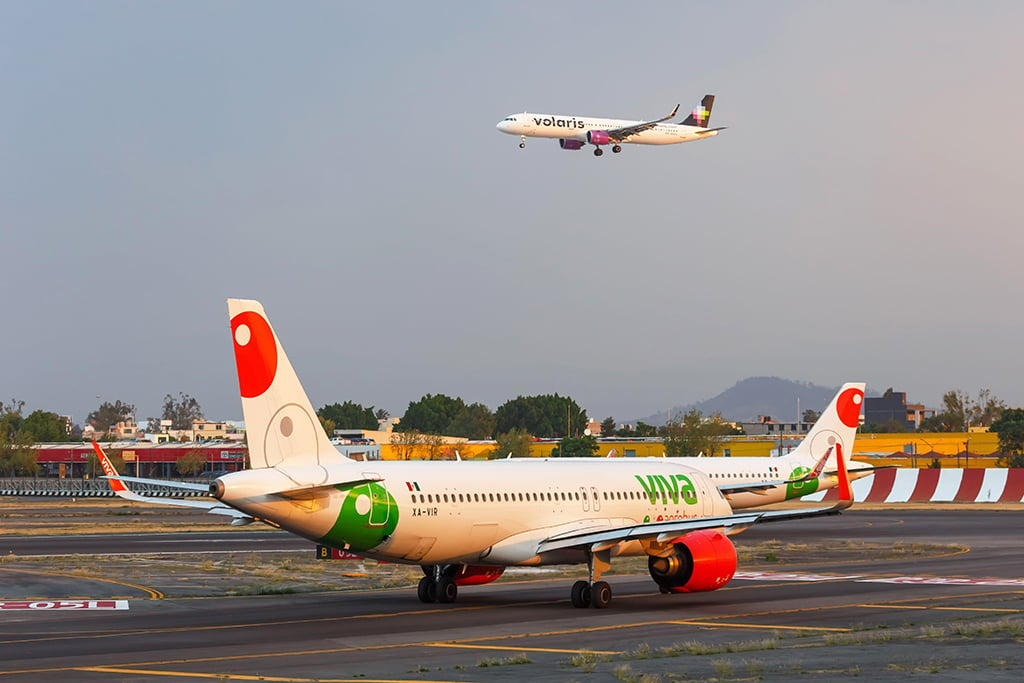
In Chapter 11, Gol could face challenges in negotiations with lessors.
Latin America was a paradox even before the COVID-19 pandemic. It was—and remains—a burgeoning growth market, but governments in the region have historically had an adverse relationship with the aviation sector. Now that 2024 is well underway, a certain level of drama has emerged in two of the region’s largest aviation markets, Brazil and Mexico, as scarcity of aircraft and political tensions become intertwined in the industry’s recovery.
- Gol’s Chapter 11 filing reflects lingering pandemic effects
- LATAM gains an unexpected spotlight in Gol’s bankruptcy proceedings
- Mexico’s policies create political tensions with the U.S.
- Will Argentina succeed in privatizing troubled Aerolineas Argentinas?
Three of Latin America’s largest operators—Aeromexico, Avianca and LATAM Airlines Group—were forced into Chapter 11 during the pandemic, largely due to a lack of financial support from governments.
Brazil’s Financial Woes
Last year, Brazilian operator Azul Airlines completed a major restructuring of its financial obligations with lessors and OEMs that included the reduction of lease payments by 5.4 billion reals ($1.1 billion in May 2023) for the next 4.5 years.
Azul rival Gol Airlines was not as fortunate and filed for Chapter 11 bankruptcy protection in the U.S. on Jan. 25. Fitch Ratings concluded in late 2023 that Gol’s recurring free cash flow pressure from high leasing and interest expenses—despite improving operating performance—had created “an unsustainable debt profile.” At the end of the third quarter of 2023, the airline’s short-term maturities were 2.9 billion reals, comprising 1.1 billion in financial debt and 1.8 billion in leasing obligations. Readily available cash, based on Fitch’s criteria, came to 905 million reals.
At the same time, Gol had roughly $200 million of a $450 million available credit line from Abra Group, the holding company for Avianca and Gol, Fitch explained. That support from Abra was a “result of another debt-restructuring transaction that Gol announced in March 2023 that also included a credit line of around $450 million,” the agency said.
After Gol filed for Chapter 11, Abra bondholders pledged $950 million in debtor-in-possession financing. Raymond James Analyst Savanthi Syth noted in a research report that, given Abra’s role in the funding, “we expect it to play a lead role in the restructuring and most likely will fold in the remaining share of Gol it doesn’t own.”
Carlos Ozores, ICF vice president and managing director for aviation, travel and tourism, said that Gol is “highly leveraged with no unsecured assets left.”
Gol operates only Boeing 737s, with an in-service fleet of 111 aircraft, according to the Aviation Week Fleet Discovery database: 45 737-8s, 13 737-700s, 47 737-800s and six 737-800Fs. It has 29 inactive aircraft, 27 of them -800s.
The airline’s challenge will be retaining the 737 MAX aircraft, which are crucial to its business plan. “These aircraft are in high demand and can easily be placed elsewhere, so there’s no incentive from lessors to offer discounts,” Ozores said.
Drama regarding Gol’s aircraft has emerged early in its restructuring process. Gol has alleged that rival LATAM Airlines Group made explicit overtures to its aircraft lessors the day after it filed for Chapter 11, even though LATAM does not operate Boeing narrowbody aircraft. LATAM Airlines Brazil is the current market share leader in Brazil’s domestic market.
At the end of 2023, LATAM’s fleet of 333 aircraft comprised 225 Airbus A320ceos, 31 A320neos, 36 Boeing 787s, a mix of 21 Boeing 777s and 767s as well as 20 767-300Fs.
In court documents, LATAM argued that it had issued a request for proposal to approximately 50 lessors for both Airbus and Boeing narrowbody aircraft. The company said that while some of them lease jets to Gol, most have no current relationship with the airline. “Put simply, LATAM is not seeking Gol’s aircraft,” the airline group stated. “LATAM is seeking any available narrowbody aircraft that meet its and its affiliates’ expectations.”
The company also explained that although it has focused on Airbus narrowbodies recently, it “has had no choice but to explore alternatives because the supply of the A320 has become so extraordinarily tight.” LATAM added that although Gol has an all-737 fleet, it “is far from the exclusive operator of the aircraft.”
But the bankruptcy court determined that Gol has “established good cause to conduct discovery” with respect to LATAM’s actions regarding these aircraft leases.
Gol’s restructuring is occurring while demand in Brazil remains strong. The latest data from Brazilian civil aviation regulator ANAC shows that from January through November 2023, Brazil had 83.5 million domestic and 19.1 international passengers—102.6 million combined. Even before the end of 2023, passenger counts surpassed the 97.6 million reached in 2022.
Mexico-U.S. Tensions
Meanwhile, Mexican President Andres Manuel Lopez Obrador has created a certain level of drama in the country’s aviation market since shortly after he took office in late 2018. He conducted a referendum in which the country voted to halt construction of a new airport near Mexico City, fulfilling a campaign pledge to scrap it. The project had initially started because the city’s main airport, Benito Juarez International Airport, was bursting at the seams. At that time, the new facility was one-third complete at a cost of $5 billion.
Lopez Obrador then unveiled plans to convert a military base into a commercial airport, and Felipe Angeles International Airport opened in March of 2022.
Since then, Mexico has required all-cargo operators to move to Felipe Angeles and limited operations at Benito Juarez to 43 from 52 per hour. The reduction was not based on technical analysis but instead was “meant to force airlines to relocate capacity to Felipe Angeles,” Ozores said. “He is bullying airlines into operating from Felipe Angeles, which is a poor substitute for MEX [Benito Juarez International Airport].”
The moves raised concerns with the U.S. government; regulators warned they violate the air transport agreement between the two countries.
Those continuing political tensions reached a crescendo when the U.S. Transportation Department tentatively rejected the renewal of the joint venture between SkyTeam Alliance partners Delta Air Lines and Aeromexico in late January. Delta holds a 20% stake in Aeromexico.
In order to gain approval for their joint venture, which debuted in 2017, Delta and Aeromexico agreed to a five-year limit on their antitrust immunity, which required the partners to reapply for the renewal of their relationship.

The Transportation Department declared that the precedent necessary for the airlines to continue their joint venture—namely the adherence “by the Government of Mexico to its obligations under the U.S.-Mexico Aviation Agreement—is no longer present.”
That conclusion is a significant blow to the SkyTeam partners, which were constrained in expanding their transborder presence after the U.S. FAA downgraded Mexico’s safety rating to Category 2 from Category 1 in May 2021. Mexico’s rating was restored to Category 1 in September 2023.
Following the safety upgrade, Delta and Aeromexico announced a significant expansion in the U.S.-Mexico transborder market. Aeromexico said it planned to operate nearly 60 daily departures to the U.S. from Mexico in July 2024, while Delta aims to operate 34 daily frequencies to seven Mexican destinations that month. Overall, the partners said they planned to offer 30% more seats on transborder routes in July 2024 versus July 2023.
Delta has made several arguments against the Transportation Department’s tentative decision. For one, the airline says its actions would not have any reasonable probability of remediating the Transportation Department’s concerns regarding the Mexican government’s compliance with the air transport agreement.
The airline also argued that the agency’s actions put nearly two dozen routes between the U.S. and Mexico at risk of cancellation and would reduce capacity; large narrowbody jets would be replaced with smaller aircraft on at least 10 other routes. Aeromexico has already trimmed its summer schedule, including removing three U.S.-bound routes from Monterrey.
It remains to be seen if the Transportation Department can change its mind. The agency in August 2023 suspended a review of a potential joint venture between Allegiant Air and Mexican operator Viva Aerobus, citing “outstanding questions relating to the continued implementation of the U.S.-Mexico air transportation agreement.”
Mexico’s government has also revived the defunct Mexicana brand, launching a state-owned airline. After fits and starts, the latest iteration of Mexicana made its debut on Dec. 26, 2023. The Aviation Week Fleet Discovery database shows the airline is operating three Boeing 737-800s.
“State airlines are a thing of the past,” Ozores said, describing the liberalization of Mexico’s aviation market in the early 2000s as “a huge success.”
He added that there is “absolutely no need for a state-owned carrier” and warned that Mexicana “introduces disloyal competition that ultimately can only hurt private airlines.”
Two of Mexico’s largest airlines—ultra-low-cost carriers (ULCC) Viva Aerobus and Volaris—are facing headwinds stemming from removals of Pratt & Whitney geared turbofan (GTF) engines powering their A320neos to check for parts with contaminated powder metal.
The two ULCCs have 40-46% of their fleet at risk for engine inspections by 2025, according to Bloomberg Intelligence aviation analyst Francois Duflot. He noted that schedule data shows a 15% capacity cut at Volaris in the first quarter compared with 2023.
Commenting on a 10.7% decrease in Volaris’ available seat miles (ASM) in January, company CEO Enrique Beltranena said accelerated inspections of GTF engines “have resulted in a significant reduction in ASMs, particularly within the Mexican domestic market.” But that reduction was balanced by increased capacity to the U.S. following Mexico’s safety upgrade.
After Volaris reached a compensation agreement with Pratt & Whitney in December 2023, TD Cowen analyst Helane Becker released a research note stating that “compensation will be a mix of cash (via other operating expense) and maintenance credits, and is expected to be front-loaded in [the first half of] 2024.”
She concluded: “While the engine removals are frustrating on the surface, we expect it to be a blessing in disguise when combined with Mexico’s restoration of Category 1, as it will help rationalize capacity in the oversupplied domestic Mexican market. Volaris should be able to keep its most profitable domestic routes and reallocate capacity into higher-yielding international lanes.”
Mexico’s next presidential election is in June, but whatever the outcome, Lopez Obrador has undoubtedly made his mark on the country’s aviation market during his six years in office.
Privatization in Argentina?
Argentina’s new President Javier Milei, meanwhile, is also working to change the country’s aviation sector. Bloomberg reported in late 2023 that he aimed to privatize state-owned Aerolineas Argentinas.
“Javier Milei has made clear he wants a small government and state footprint in the national economy,” Bloomberg’s Duflot says. “Privatization of the airline would fit with his plan, though the airline may need some restructuring first after 15 years or so of losses.”
Aerolineas Argentinas needs to “cut bloat to increase margin and profit and desirability,” he notes. “A profitable airline would get the government better offers and more needed cash.”
For now, no definitive plan has emerged from the government to shed the state-owned enterprise, which was renationalized in 2008.
Mixed Results
With the churn continuing in Argentina, Brazil and Mexico, the International Air Transport Association projected in December 2023 that Latin American airlines would generate a $600 million loss for the year. “The performance of airlines across the region has been very mixed; some are performing strongly while others find themselves in considerable financial difficulties, including being in or coming out of Chapter 11 proceedings,” the association stated.
Economic and social stability in Latin America are key factors for long-term profitability, Duflot said, “though airlines with a larger, international network could fare better on diverse exposures.” Deregulation and lower taxes on airlines, fuel, airports and tickets would also benefit airlines, he added.
At the moment, one government-run airline is attempting to carve out a place in Mexico’s market, while the fate of a long-troubled state-run airline in Argentina remains uncertain.





